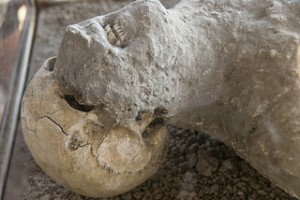When the average person hears the terms “microbiology” and “genetics,” often mental images involving lab coats, complicated chemical reactions, forensic TV shows, and futuristic advancements come to mind. However, just this week, a team of scientists at the University of York published a paper in “Nature Genetics” (Christina Warinner et al, Pathogens and host immunity in the ancient human oral cavity, unfortunately a subscription is necessary) that headed in the opposite direction. These researchers found an entombed microbiome inside the plaque on a skeleton preserved in the ashes of Pompeii.
This discovery is the key to learning much more about the genetic and microbial climate of the past. Bone rapidly looses genetic information once in a ground environment, but calculus (fossilized dental plaque) is very effective at preserving biomolecules in its hardened state. So much more information has been unlocked about the lifestyles of these ancient peoples from their food sources to their agricultural tendencies, and even their limited medicinal techniques. This article stood out to me because it reinforces the notions that we all live in a world completely dependent on things we can’t even see, that microbes aren’t something to be afraid of, and that advancements in the fields of genetics and other sciences are everyones business, not just those of us that wear lab coats everyday.
Andrew Stump is an undergraduate at UC Davis, working in the lab of Jonathan Eisen on describing a new bacterial species isolated from the built environment.

Pompeii, Italy